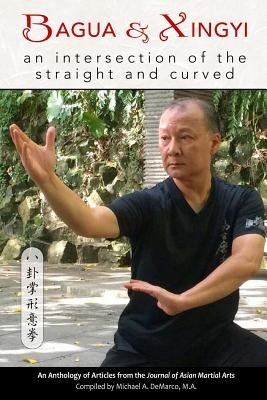
- We will send in 10–14 business days.
- Author: Kevin Craig
- Publisher: Via Media Publishing Company
- Year: 2016
- Pages: 176
- ISBN-10: 1893765334
- ISBN-13: 9781893765337
- Format: 15.2 x 22.9 x 1 cm, minkšti viršeliai
- Language: English
- SAVE -10% with code: EXTRA
Reviews
Description
Baguaquan and xingyiquan are two styles that complement each other as yin does yang. Bagua is known for its circular movements and its practice of circle walking. Xingyi embodies characteristic linear movements said to be derived form the logical strategies for using spear and staff. How fortunate we are to include writings in this anthology by leading authorities on these styles. Separated into three sections, the first features bagua. Allen Pittman presents five variations of the single palm change, followed by an overview of the Yin Fun bagua lineage and an interview with He Jinbao focusing on training, fighting skills, teaching and learning. Travis Joern examines how a martial artist can apply the theoretical aspects of the Book of Changes to bagua training. Hong Dzehan (son of Hong Yixiang, stellar master of the three internal systems) then shares some of his personal experiences and favorite bagua techniques. Section two contains chapters on xingyi. The interview with Luo Dexiu questions the proper way to study xingyi from the beginning to the advanced levels. Robert Yu compares American boxing with xingyi's pragmatic fighting techniques and in the following chapter he recounts in detail how it was to study under Hong Yixiang in Taiwan nearly forty years ago. Stanley Henning gives a travelogue of a trip to Shanxi Province (the home of xingyi) and then discusses Che Style xingyi training methods as thought by Dr. Wu Chaoxiang, including the five element theory, twelve animal forms, two-person routines, and spear training. The third section presents some commonalities in what many refer to as the internal arts: bagua, xingyi, and taiji. The chapter on Fu family style beautifully details how they incorporated the essential elements of taiji, xingyi, and bagua into their majestic sixiangquan (four image boxing). Marcus Brinkman relates many of the unique insights and experiences he had during his extensive study with Lo Dexiu and Hong Yixiang, including internal development and fighting applications. Tim Cartmell provides the final chapter which explains the key concepts of "sticking and following" as they apply to the throwing methods of the Chinese internal martial arts. The rich content in this anthology comes from the rare academic and hands-on experience of those presented in chapters here. Readers will no doubt benefit from the practical practice tips as well as the other cultural details these wonderful authors share.
EXTRA 10 % discount with code: EXTRA
The promotion ends in 23d.19:11:36
The discount code is valid when purchasing from 10 €. Discounts do not stack.
- Author: Kevin Craig
- Publisher: Via Media Publishing Company
- Year: 2016
- Pages: 176
- ISBN-10: 1893765334
- ISBN-13: 9781893765337
- Format: 15.2 x 22.9 x 1 cm, minkšti viršeliai
- Language: English English
Baguaquan and xingyiquan are two styles that complement each other as yin does yang. Bagua is known for its circular movements and its practice of circle walking. Xingyi embodies characteristic linear movements said to be derived form the logical strategies for using spear and staff. How fortunate we are to include writings in this anthology by leading authorities on these styles. Separated into three sections, the first features bagua. Allen Pittman presents five variations of the single palm change, followed by an overview of the Yin Fun bagua lineage and an interview with He Jinbao focusing on training, fighting skills, teaching and learning. Travis Joern examines how a martial artist can apply the theoretical aspects of the Book of Changes to bagua training. Hong Dzehan (son of Hong Yixiang, stellar master of the three internal systems) then shares some of his personal experiences and favorite bagua techniques. Section two contains chapters on xingyi. The interview with Luo Dexiu questions the proper way to study xingyi from the beginning to the advanced levels. Robert Yu compares American boxing with xingyi's pragmatic fighting techniques and in the following chapter he recounts in detail how it was to study under Hong Yixiang in Taiwan nearly forty years ago. Stanley Henning gives a travelogue of a trip to Shanxi Province (the home of xingyi) and then discusses Che Style xingyi training methods as thought by Dr. Wu Chaoxiang, including the five element theory, twelve animal forms, two-person routines, and spear training. The third section presents some commonalities in what many refer to as the internal arts: bagua, xingyi, and taiji. The chapter on Fu family style beautifully details how they incorporated the essential elements of taiji, xingyi, and bagua into their majestic sixiangquan (four image boxing). Marcus Brinkman relates many of the unique insights and experiences he had during his extensive study with Lo Dexiu and Hong Yixiang, including internal development and fighting applications. Tim Cartmell provides the final chapter which explains the key concepts of "sticking and following" as they apply to the throwing methods of the Chinese internal martial arts. The rich content in this anthology comes from the rare academic and hands-on experience of those presented in chapters here. Readers will no doubt benefit from the practical practice tips as well as the other cultural details these wonderful authors share.


Reviews